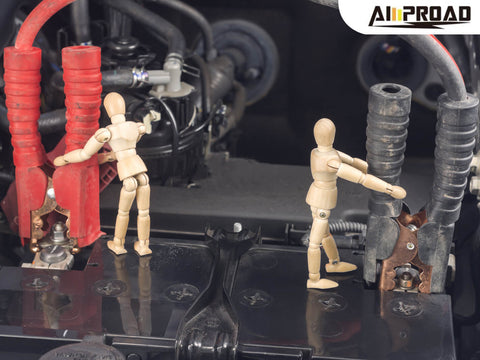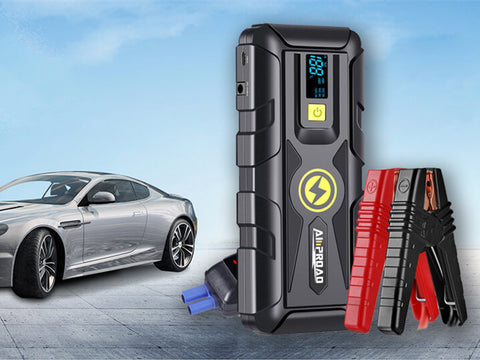
Forget the stopwatch! Traditionally, jump-starting advice revolves around a magic number of minutes to leave the cables connected. But what if there's a better way? This guide ditches the timer and focuses on achieving a safe, effective jump-start, with connection time playing a supporting role.
Our goal? Get your car back on the road quickly and safely, avoiding unnecessary risks to both you and your vehicle. Instead of a rigid time limit, we'll explore the ideal connection window – that sweet spot where your dead battery gets the jolt it needs to crank the engine without lingering too long. We'll also discuss clear signs that it's time to disconnect the cables, ensuring a smooth jump-start that gets you back on your journey, minus the worry. So, ditch the clock and focus on the winning formula for a successful jump!
How to Determine the Perfect Connection Time?
When jump-starting a vehicle, it's essential to understand that the perfect connection time isn't about sticking to a strict limit. Rather, it's about providing sufficient power transfer to kick-start the dead battery without overdoing it.
Balancing Power Transfer
The primary goal of jump-starting is to transfer enough power to the dead battery to enable it to crank the engine successfully. However, leaving the connection for too long can lead to potential risks such as overloading the electrical systems or damaging the batteries.
Monitoring Battery Response
As you connect the jumper cables, pay attention to how the dead battery responds. If it begins to show signs of life, such as lights turning on or the engine attempting to start, you're on the right track. At this point, it's crucial to disconnect the cables promptly to avoid overloading the electrical system.
Avoiding Excessive Connection
While it may be tempting to leave the connection for an extended period, especially if the dead battery seems particularly drained, doing so can pose risks. Overloading the electrical system or damaging the batteries can result from leaving the connection for too long.
Safety First
Always prioritize safety when jump-starting a vehicle. If the dead battery doesn't respond after a reasonable amount of time, it's best to seek professional assistance or explore alternative solutions. Additionally, be mindful of any signs of overheating or unusual smells, as these could indicate underlying issues that require attention.
When to Disconnect the Cables Safely?
When jump-starting a vehicle, knowing how to boost a car properly and when to disconnect the cables is crucial for safety and effectiveness. Instead of focusing solely on time, pay close attention to how the car responds to the jump-start attempt.
Successful Engine Start
If the engine starts successfully after connecting the jumper cables, it's time to disconnect them promptly. Start by removing the positive cable (red) followed by the negative cable (black) in the correct order to prevent any sparks or electrical mishaps.
Engine Cranks but Doesn't Start
In cases where the engine cranks but fails to start, it's essential to delve deeper into the underlying issue. While a dead battery might be the initial problem, it's not always the sole culprit. Consider other potential issues such as faulty spark plugs or alternator problems that could be preventing the engine from starting.
Prioritizing Safety
Regardless of the car's response, always prioritize safety when jump-starting a vehicle. Disconnect the jumper cables carefully and in the correct order to avoid any sparks or electrical hazards. Additionally, be mindful of any signs of overheating or unusual smells, as these could indicate underlying issues that require attention.
Seeking Professional Assistance
If the engine fails to start even after a successful jump-start attempt, it's advisable to seek professional assistance. A qualified mechanic can conduct a thorough inspection to identify and address any underlying issues contributing to the starting problem. Avoid attempting multiple jump-starts without investigating the root cause, as this could potentially cause further damage to the vehicle's electrical system or components.
Knowing when to disconnect the jumping starter is essential for safe and effective jump-starting. By focusing on the car's response rather than adhering strictly to a time limit, you can ensure a smoother and safer jump-start process. Always prioritize safety and consider seeking professional assistance if the engine fails to start despite a successful jump-start attempt.
What Are the Potential Risks of Extended Connection?
Extended connection of jumper cables poses significant risks to both vehicles involved in the jump-start process. It's crucial to be aware of these potential dangers to avoid damage and ensure a safe jump-start experience.
Electrical Damage
Leaving cables connected for an extended duration can result in electrical damage to various components in both vehicles. The flow of electricity through the cables can overload sensitive electronic systems, leading to malfunctions or even permanent damage. Components such as onboard computers, alternators, and other electrical parts are particularly vulnerable to this risk.
Overheating and Fire Hazards
Prolonged connection of jumper cables can also increase the risk of overheating, potentially resulting in fire hazards. The continuous flow of electricity generates heat, which can accumulate over time and cause cables or electrical components to become dangerously hot. In extreme cases, this heat buildup can lead to insulation melting, sparks, or even fires, posing a significant safety threat to both vehicles and occupants.
As per the analysis, Extended connection of car booster pack can result in electrical damage and pose fire hazards to vehicles involved in the jump-start process. To mitigate the risks associated with extended connection of jumper cables, it's essential to adhere to recommended connection durations and monitor the jump-start process closely. Avoid leaving cables connected for longer than necessary, and promptly disconnect them once the dead vehicle starts. Additionally, keep a close eye on both vehicles for any signs of overheating or electrical issues during the jump-start process. By understanding these potential risks and prioritizing safety, you can ensure a smoother and safer jump-start experience. Be vigilant, adhere to recommended connection durations, and promptly disconnect the cables to mitigate the dangers associated with prolonged connection.
Are There Additional Safety Tips for a Smooth Jump-Start?
When performing a jump-start, it's essential to park both vehicles in a well-ventilated area, away from any flammable materials. This precaution helps minimize the risk of fire hazards, especially considering the potential for sparks during the jump-start process.
Proper Cable Connection
Ensure that the jumper cables are correctly connected to the designated terminals on both vehicles. The positive (red) clamp should be attached to the positive terminal of the dead battery, while the negative (black) clamp should connect to a suitable grounding point on the vehicle's frame or engine block. Connecting the cables in the correct order prevents potential damage to the vehicle's electrical system and ensures a safe jump-start.
Consider a Portable Jump Starter
For added convenience and safety during jump-starting, consider using a portable jump starter. These compact devices offer a standalone solution for jump-starting vehicles without the need for another vehicle's assistance. AMPROAD offers a versatile portable jump starter that can provide reliable power for jump-starting gas and diesel cars. With its adjustable 40A amp rates, it's one of the fastest home level 2 EV chargers. Additionally, portable jump starters eliminate the risk of incorrect cable connections and minimize the chances of accidental sparks or electrical mishaps.
Clamp Safety
Avoid touching the positive and negative clamps together while connected to the batteries. Doing so can create a short circuit, leading to sparks, arcing, or electrical shocks. Always handle the jumper cables with care and ensure that the clamps are securely attached to the battery terminals before attempting to jump-start the vehicle.
By following these additional safety tips, you can ensure a smooth and secure jump-start process, minimizing the risk of accidents or damage to vehicles and ensuring a successful jump-start experience.
FAQs / People Also Ask
Q: How long should jumper cables be left connected during a jump-start?
A: The recommended duration for connecting vehicles during a jump start is typically brief, usually around 5 to 10 minutes.
Q: What happens if jumper cables are left connected for too long?
A: Leaving cars connected for an extended duration during a jump start can potentially lead to damage, including overloading the electrical systems and risking damage to sensitive electronic components.
Q: How can I ensure a safe jump-start process?
A: It's important to be familiar with the warning signs of potential issues, such as unusual sounds or odors, and know how to safely disconnect the jumper cables in case of an emergency.
Q: Can I use any type of jumper cables for a jump start?
A: It's recommended to use high-quality jumper cables with sufficient gauge to handle the current flow during a jump start, reducing the risk of overheating or damage.
Q: What are some precautions to take after disconnecting the jumper cables?
A: After disconnecting the cables, it's advisable to let the boosted vehicle run for a few minutes to allow the alternator to recharge its battery fully and drive the vehicle for a reasonable distance to continue charging the battery.





